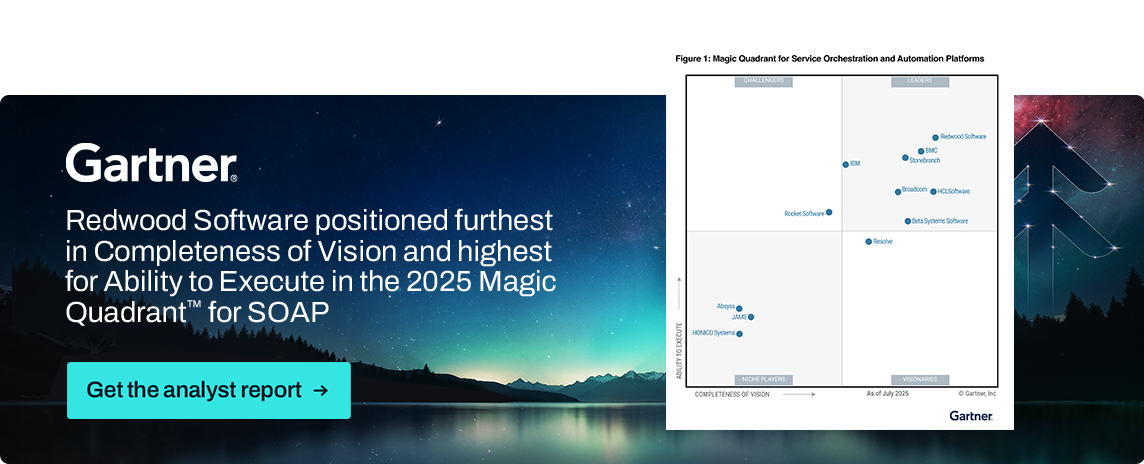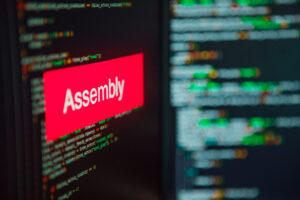Gartner®: Revamp IT with Service Orchestration and Automation Platforms
IT teams are moving to Service Orchestration and Automation Platforms (SOAPs). Find out how SOAPs can drive innovation and what you need to get started.

Gartner®, the leading research organization for the IT industry, expects I&O leaders to continue moving towards a new form of workload automation. Here’s why.
Service Orchestration and Automation Platforms (SOAPs) are modern workload automation solutions that provide integrations with a variety of other tools. But not all workload automation solutions are considered SOAPs, and it’s important to understand their evolving role in IT automation.
In the 2025 Gartner® Magic Quadrant™ for SOAPs report, Gartner predicts that, “by 2029, 90% of organizations currently delivering workload automation will be using service orchestration and automation platforms (SOAPs) to orchestrate workloads and data pipelines in hybrid environments across IT and business domains.”
How did workload automation become SOAP?
Workload automation (WLA) has evolved quite a bit over the years.
1980s–1990s: Workload automation offers limited capabilities for particular purposes: to automate the execution of batch processes in homogeneous environments.
2000s–2010s: To help IT teams manage digital proliferation, some WLA vendors double down on developing integrations. Instead of just handling mainframe-centric batch processes, WLA tools can be used to manage workloads across data centers, ERP and CRM tools, BI platforms and more.
2010s–2020s: Those same WLA vendors provide API accessibility, enabling IT teams to also manage processes and resources across on-premises and cloud-based systems. Machine learning comes on the scene to analyze historical and real-time data for process optimization.
Modern WLA solutions have little in common with their predecessors of the 1980s and 1990s. Yes, they can still manage batch processes, but that’s about where the comparison ends.
As we’ll see, the ability to support cloud orchestration across a variety of service providers is what defines a SOAP.

What are Service Orchestration and Automation Platforms (SOAPs)?
SOAPs, as defined in the 2025 Gartner Magic Quadrant™ for SOAPs report, “empower infrastructure and operations (I&O) leaders to streamline and accelerate the delivery of business services. These platforms integrate workflow orchestration, workload automation and resource provisioning across an organization’s hybrid IT landscape. By automating and optimizing these processes, SOAPs enable organizations to rapidly deploy workloads, enhance operational efficiency and achieve significant cost savings while ensuring high availability and business continuity.”
Much like digital process automation tools, SOAPs enable IT to build and optimize end-to-end processes that streamline data and service delivery.
However, in order to achieve this, SOAPs must be able to manage dependencies across virtually any other technology the organization is using, through pre-built, universal connectors, native integrations or API accessibility.
Think of SOAPs as a layer that sits above the organization’s applications, systems and resources. SOAPs abstract away the complexity of end-to-end processes so that IT can manage data and resources across an organization.
SOAPs provide orchestration capabilities for a variety of use cases:
- Business applications
- IT operations and infrastructure
- Network services/network management
- DevOps initiatives
- Microservices
- IT service management/service lifecycle
- Data management and ETL processes
- Big data
Common SOAP features and capabilities
The ability to integrate disparate applications and systems is key to orchestrating IT and business processes. SOAPs also support a range of additional capabilities and features to help IT manage and optimize those processes from a single location.
When SOAPs were first debuted, Gartner shared six SOAP capabilities: Event-driven automation, workflow design, monitoring and alerting, resource provisioning, self-service automation and mobile applications. In the 2025 Gartner® Magic Quadrant™ for Service Orchestration and Automation Platforms report, Gartner shares five mandatory features:
- Management of workloads in complex technology and deployment topologies: This includes supporting mission-critical workload automation of business processes in various combinations and configurations of internally developed applications. It also involves supporting commercial off-the-shelf (COTS) products and infrastructure deployments, including on-premises, cloud, colocation, software as a service (SaaS) and edge locations.
- Management of workflows spanning the operating environment: This includes request management, integration between IT software platforms and end-user enablement, data pipelines, citizen developer enablement, and DevOps pipeline integration.
- Broad integration capabilities: This includes the ability to integrate with and incorporate software and infrastructure technology landscapes that span from the cloud to enterprise applications.
- Workflow design: This includes providing a visual workflow designer, a code-based designer and a library to create and reuse workflow templates. Additionally, it needs to support version control and collaboration, allowing multiple users to work on workflows simultaneously and track changes.
- Error handling and recovery: This ensures workflow stability by detecting errors, triggering recovery actions such as retries or rollbacks, and minimizing disruptions. Robust logging and alerts enable rapid diagnosis and resolution, maintaining reliability and data integrity.
And some additional common features:
- Mobile or web portal interaction capabilities for end users
- Jobs-as-code development capabilities to facilitate DevOps interactions with platform
- Event-driven automation to respond to events as they occur with workflow execution
- Generative AI (GenAI) support for productivity and advanced AI utilization in the solution
- Data pipeline support to deliver advanced data tasks, directly in support of infrastructure build and more complex workflows that cross technology domains
- Defining, executing, managing and notifying on workloads and workflows that are executed
- Providing job scheduling, job definition and execution, dependency management among steps and enabling plan/predict/optimize actions that ensure service-level agreement (SLA) management
Why IT teams are using SOAPs
It used to be enough to schedule batch processes that provided end-of-day or end-of-week reports. In contrast, today’s organizations require real-time analytics, rely on a host of cloud-based services and applications and are required to deliver seamless customer experiences to maintain market share.
This proliferation of data and digital tools has made it increasingly difficult for IT to provide required services and maintain business agility. Data must often be managed across multiple, disparate systems and applications that can span both on-premises and cloud environments.
Service orchestration and automation platforms are essential for delivering business services through complex workloads.
2025 Gartner® Magic Quadrant™ for Service Orchestration and Automation Platforms report
Service Orchestration and Automation Platforms can drastically simplify the management of dependencies and data across systems, saving IT time, minimizing the risk of issues and reducing time-to-market for innovative new services and solutions.
How to choose the right SOAP for your organization
SOAPs are designed to be the linchpin of an organization’s automation strategy, integrating and orchestrating everything from cloud infrastructure and applications to on-premises data centers. SOAPs should be treated as a critical component of an enterprise’s long-term digital transformation.
As such, there are several things technology users should consider when selecting a SOAP vendor:
- Support for cloud-native infrastructure (Microsoft Azure, Amazon AWS, Google Cloud) via native integrations or low-code API accessibility
- Native integrations available for the organization’s existing technologies and toolchains
- Quality of customer support
- The vendor’s long-term viability and roadmap for product development
Redwood Software was named a Leader in the 2025 Gartner® Magic Quadrant™ for SOAPs report, positioned furthest in Completeness of Vision and highest for Ability to Execute. ActiveBatch by Redwood is part of Redwood’s suite of automation fabric solutions. Book a demo to find out more.
Ready to simplify your data warehousing with workload automation?
Schedule a demo to watch our experts run jobs that match your business requirements in ActiveBatch. Get your questions answered and learn how easy it is to build and maintain your jobs.
GARTNER is a registered trademark and service mark of Gartner, Inc. and/or its affiliates in the U.S. and internationally, and MAGIC QUADRANT is a registered trademark of Gartner, Inc. and/or its affiliates and are used herein with permission. All rights reserved.
These graphics were published by Gartner, Inc. as part of a larger research document and should be evaluated in the context of the entire document. The Gartner document is available upon request from https://www.advsyscon.com/en-us/resource/gartner-soaps-mq.







